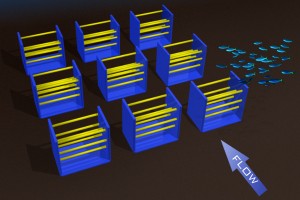The UK Telegraph is reporting on researchers from the University of Michigan that have created a vortex based power generator that can operate in water moving between 1 and 3 miles per hour, which is the average speed of the majority of moving water on the planet.
The new device, which has been inspired by the way fish swim, consists of a system of cylinders positioned horizontal to the water flow and attached to springs.
As water flows past, the cylinder creates vortices, which push and pull the cylinder up and down. The mechanical energy in the vibrations is then converted into electricity.
Cylinders arranged over a cubic metre of the sea or river bed in a flow of three knots can produce 51 watts. This is more efficient than similar-sized turbines or wave generators, and the amount of power produced can increase sharply if the flow is faster or if more cylinders are added.
Generating power at roughly 51 watts per cubic meter, the potential for pulling commercial grade power out of a river is nowhere near what it could be using a dam, however the far less disruptive method could prove useful as a power offset (small part of overall green power input that includes solar, wind, etc).
The one thing that always gets me is how articles say “how many homes” something like this could power, which is always off. This article says a 1km by 1.5km section of seabed covered in these things could power 100,000 homes. That is total bullshit.
An area the size of 1000 meters by 1500 meters is 1,500,000 cubic meters. If each cubic meter generates roughly 51 watts, then you’d get approximately 76,500,000 watts out of that installation. Considering that in 2007, an average American home consumed about to 936kWh per month. That means each home would require 31.2kWh per day, or 1.3kW per hour to operate. So, if you divide 76,500,000W by 1300W you only get 58,846 homes… about half what the article is reporting. Maybe you could run 100,000 studio apartments off this tech using 1,500,000 cubic meters of ocean floor, but not typical Michigan homes.
All in all though, its an impressive piece of technology that makes use of low levels of kinetic energy to generate power. Nice work UoM!













